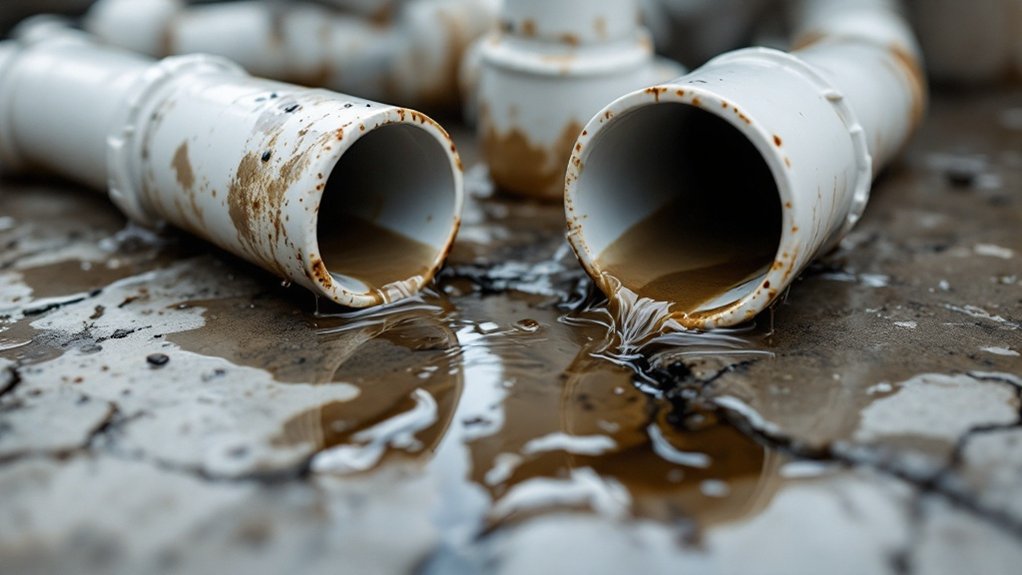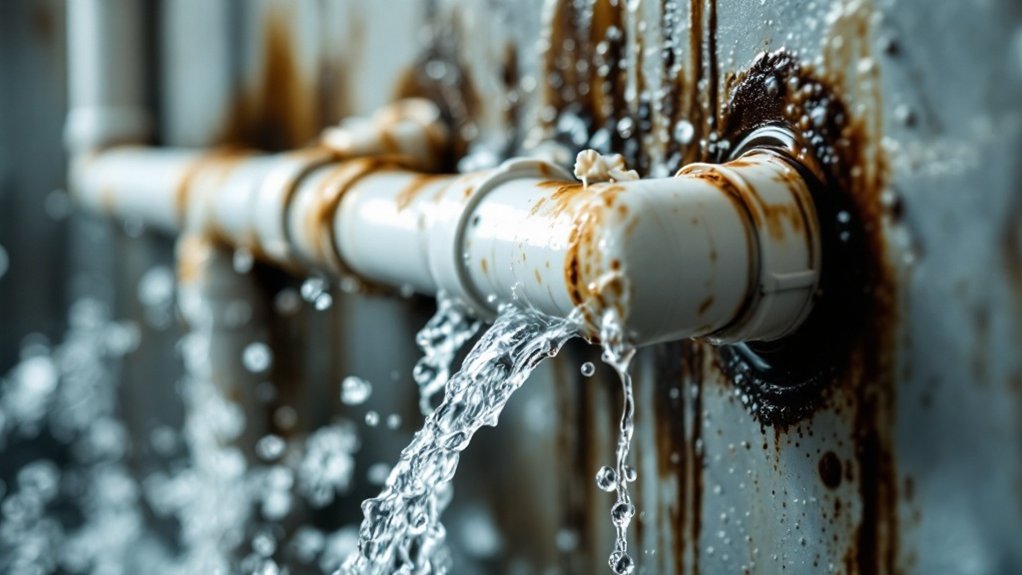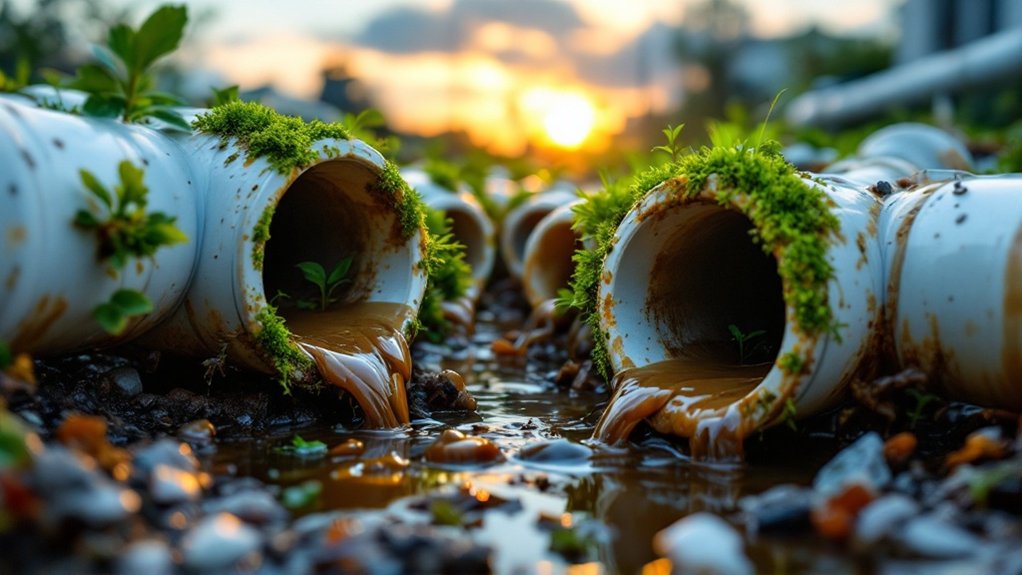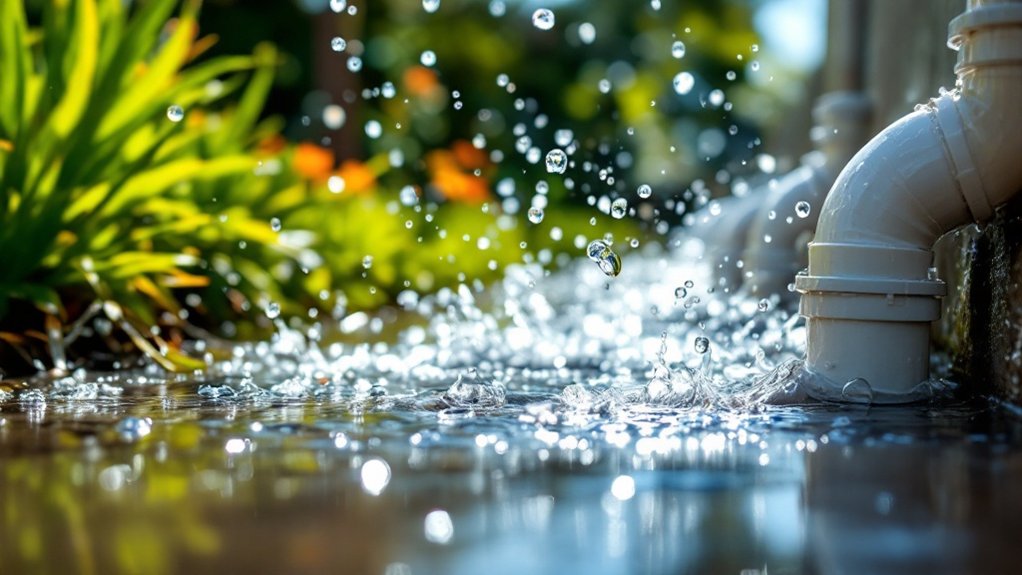Failing to glue PVC drainage pipes together leads to inevitable leaks through microscopic gaps at joints. You’ll face progressive water seepage, structural weakness, and eventual system failure as pressure exploits these vulnerabilities. Unsecured connections risk pipe separation, alignment issues, and environmental contamination. Without proper adhesion, your plumbing system becomes susceptible to pressure surges and costly damage. Regular inspection and proper gluing techniques are essential safeguards against these potentially catastrophic consequences.
Key Takeaways
- Unglued PVC joints inevitably develop leaks as water pressure exploits microscopic gaps between pipe surfaces.
- Structural integrity becomes compromised, increasing risks of joint failure under normal water pressure.
- Pipes may separate completely during pressure surges, leading to catastrophic system failures and property damage.
- Loose connections allow pipe misalignment, creating areas for debris accumulation and potential blockages.
- Long-term exposure to moisture at unsealed joints accelerates pipe degradation and increases maintenance costs.
Inevitable Leakage: The Primary Risk of Unglued PVC Pipes

While unglued PVC drainage pipes may appear stable during initial installation, they inevitably develop leaks over time, as any professional drainage contractor will tell you. This occurs because PVC pipe connections can’t achieve perfect contact without adhesive, creating microscopic gaps at the joints.
Water pressure exploits these gaps, leading to progressive leakage that worsens as pipes experience ongoing pressure and potential erosion. The physical nature of PVC fittings means they’re designed specifically for glued application.
Regular joint inspection is essential if you’ve installed unglued pipes. Implement systematic leak detection procedures to identify problems before they cause significant damage. Additionally, consider utilizing stormwater management solutions to help mitigate potential issues caused by drainage inefficiencies.
Without proper sealing, your drainage system remains vulnerable even if it initially functions correctly.
Compromised Structural Integrity Under Pressure

As pressure builds within a drainage system, unglued PVC pipes face significant structural vulnerabilities that compromise their integrity.
Without proper chemical bonding, these connections can’t withstand internal pressure forces, dramatically reducing pipe strength and increasing burst risk.
Your drainage system’s pressure performance deteriorates as these compromised joints allow water seepage and eventual failure.
The structural support necessary for long-term durability is absent, making unglued pipes susceptible to environmental factors, vibration, and material fatigue.
Safety hazards emerge as these weakened connections may catastrophically fail under normal operating conditions, potentially causing water damage to your property and necessitating costly emergency repairs.
Environmental Degradation of Unsecured PVC Connections

Unsecured PVC connections face significant environmental degradation risks beyond pressure-related failures.
Without proper sealing, these connections become vulnerable to chemical leaching, where toxins from the PVC matrix can migrate into water systems. You’ll find that temperature fluctuations and environmental stressors accelerate this degradation process.
Unglued connections also create pathways for groundwater contamination as system leakage introduces chemicals into surrounding soil.
This contamination extends to nearby water ecosystems, affecting aquatic life and potentially entering drinking water supplies.
Additionally, soil chemistry and microbial activity can penetrate these compromised connections, further degrading the PVC material and exacerbating ecological damage through continuous chemical release.
Installation Failures: When Pipes Come Apart
Pipe separations resulting from non-glued PVC connections constitute one of the most critical installation failures you’ll encounter in drainage systems. Unsecured connections compromise pipe alignment, leading to system-wide collapse under pressure surges or external forces.
| Failure Type | Consequence |
|---|---|
| Over-belling | Direct pipe stress |
| Poor adhesion | Connection separation |
| Soil erosion | Support structure collapse |
| Pressure surge | Catastrophic system failure |
Connection durability depends entirely on proper gluing techniques. Without secure bonds, your pipes remain vulnerable to leakage, contamination, and structural compromise. These failures typically result in expensive repairs, regulatory violations, and potential legal liabilities—especially when environmental damage occurs.
Long-Term Maintenance Nightmares and Prevention Strategies
The long-term maintenance implications of non-glued PVC drainage systems extend far beyond initial installation problems, creating persistent challenges throughout the system’s operational lifespan.
You’ll face increased complexity during repairs as unglued connections shift unpredictably. Chronic moisture accumulation leads to structural deterioration, while debris builds up at loose joints, compromising flow efficiency.
Implement these preventive measures: apply appropriate primer and solvent cement to create permanent bonds, guarantee clean surfaces before application, and allow proper curing time.
Maintenance tips include regular inspection of accessible pipes for early leak detection and protecting PVC from harsh chemicals and temperature extremes.




